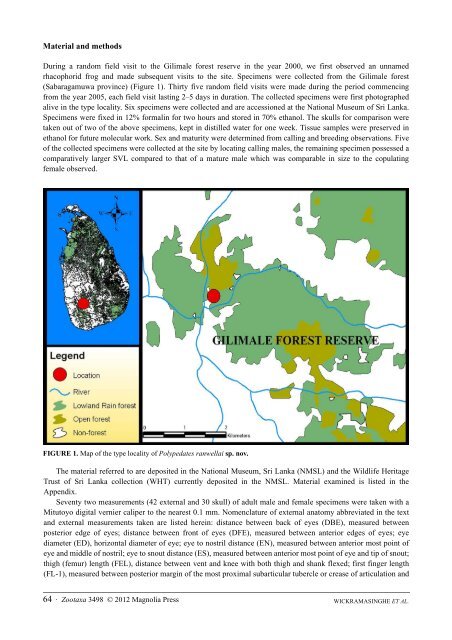A New Species of Polypedates Tschudi
A new species of frog tentatively assigned to the genus Polypedates is described from the Gilimale forest reserve of the Sabaragamuwa province of Sri Lanka. This tree frog is characterized by unique osteological characteristics in the skull which distinguish it from all other congeners, such as the presence of a series of maxillary teeth progressively changing orientation from horizontal to vertical from …
A new species of frog tentatively assigned to the genus Polypedates is described from the Gilimale forest reserve of the Sabaragamuwa province of Sri Lanka. This tree frog is characterized by unique osteological characteristics in the skull which distinguish it from all other congeners, such as the presence of a series of maxillary teeth progressively changing orientation from horizontal to vertical from …
You also want an ePaper? Increase the reach of your titles
YUMPU automatically turns print PDFs into web optimized ePapers that Google loves.
Material and methods<br />
TERMS OF USE<br />
This pdf is provided by Magnolia Press for private/research use.<br />
Commercial sale or deposition in a public library or website is prohibited.<br />
During a random field visit to the Gilimale forest reserve in the year 2000, we first observed an unnamed<br />
rhacophorid frog and made subsequent visits to the site. Specimens were collected from the Gilimale forest<br />
(Sabaragamuwa province) (Figure 1). Thirty five random field visits were made during the period commencing<br />
from the year 2005, each field visit lasting 2–5 days in duration. The collected specimens were first photographed<br />
alive in the type locality. Six specimens were collected and are accessioned at the National Museum <strong>of</strong> Sri Lanka.<br />
Specimens were fixed in 12% formalin for two hours and stored in 70% ethanol. The skulls for comparison were<br />
taken out <strong>of</strong> two <strong>of</strong> the above specimens, kept in distilled water for one week. Tissue samples were preserved in<br />
ethanol for future molecular work. Sex and maturity were determined from calling and breeding observations. Five<br />
<strong>of</strong> the collected specimens were collected at the site by locating calling males, the remaining specimen possessed a<br />
comparatively larger SVL compared to that <strong>of</strong> a mature male which was comparable in size to the copulating<br />
female observed.<br />
FIGURE 1. Map <strong>of</strong> the type locality <strong>of</strong> <strong>Polypedates</strong> ranwellai sp. nov.<br />
The material referred to are deposited in the National Museum, Sri Lanka (NMSL) and the Wildlife Heritage<br />
Trust <strong>of</strong> Sri Lanka collection (WHT) currently deposited in the NMSL. Material examined is listed in the<br />
Appendix.<br />
Seventy two measurements (42 external and 30 skull) <strong>of</strong> adult male and female specimens were taken with a<br />
Mitutoyo digital vernier caliper to the nearest 0.1 mm. Nomenclature <strong>of</strong> external anatomy abbreviated in the text<br />
and external measurements taken are listed herein: distance between back <strong>of</strong> eyes (DBE), measured between<br />
posterior edge <strong>of</strong> eyes; distance between front <strong>of</strong> eyes (DFE), measured between anterior edges <strong>of</strong> eyes; eye<br />
diameter (ED), horizontal diameter <strong>of</strong> eye; eye to nostril distance (EN), measured between anterior most point <strong>of</strong><br />
eye and middle <strong>of</strong> nostril; eye to snout distance (ES), measured between anterior most point <strong>of</strong> eye and tip <strong>of</strong> snout;<br />
thigh (femur) length (FEL), distance between vent and knee with both thigh and shank flexed; first finger length<br />
(FL-1), measured between posterior margin <strong>of</strong> the most proximal subarticular tubercle or crease <strong>of</strong> articulation and<br />
64 · Zootaxa 3498 © 2012 Magnolia Press<br />
WICKRAMASINGHE ET AL.















